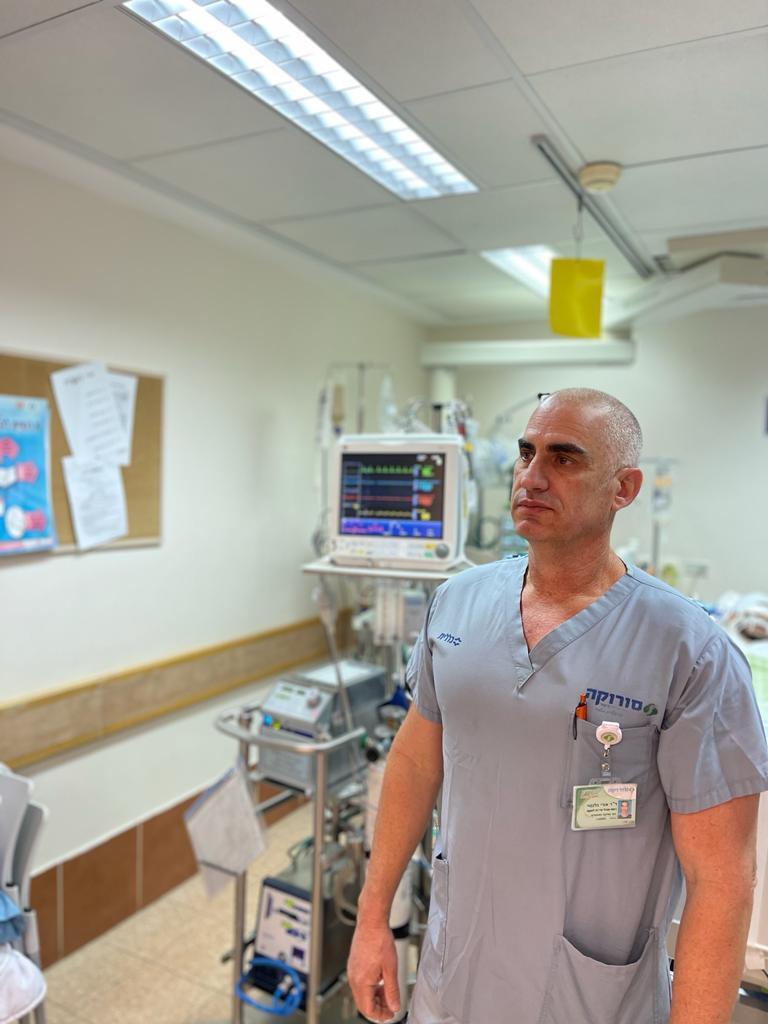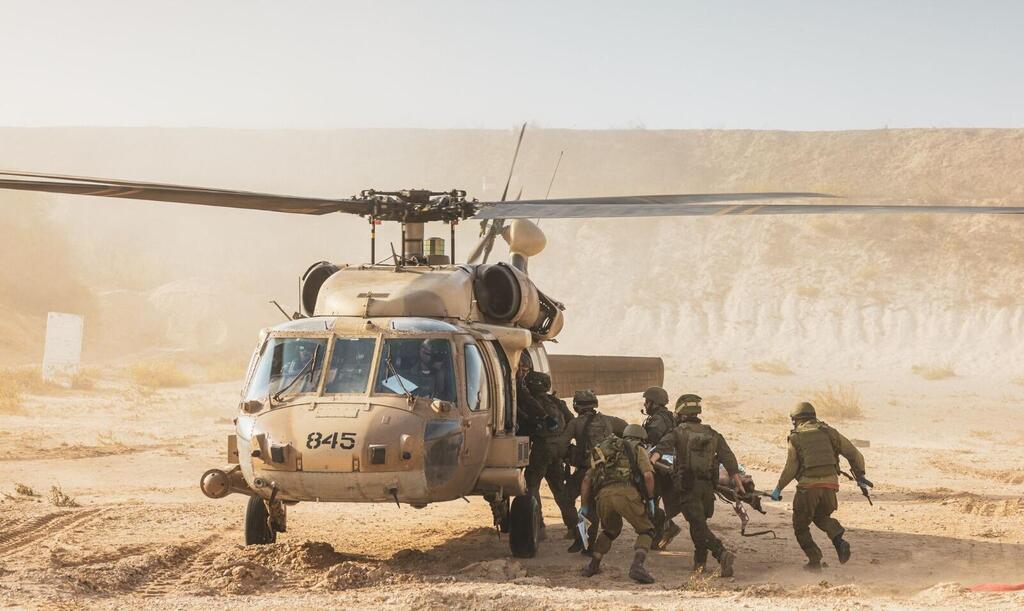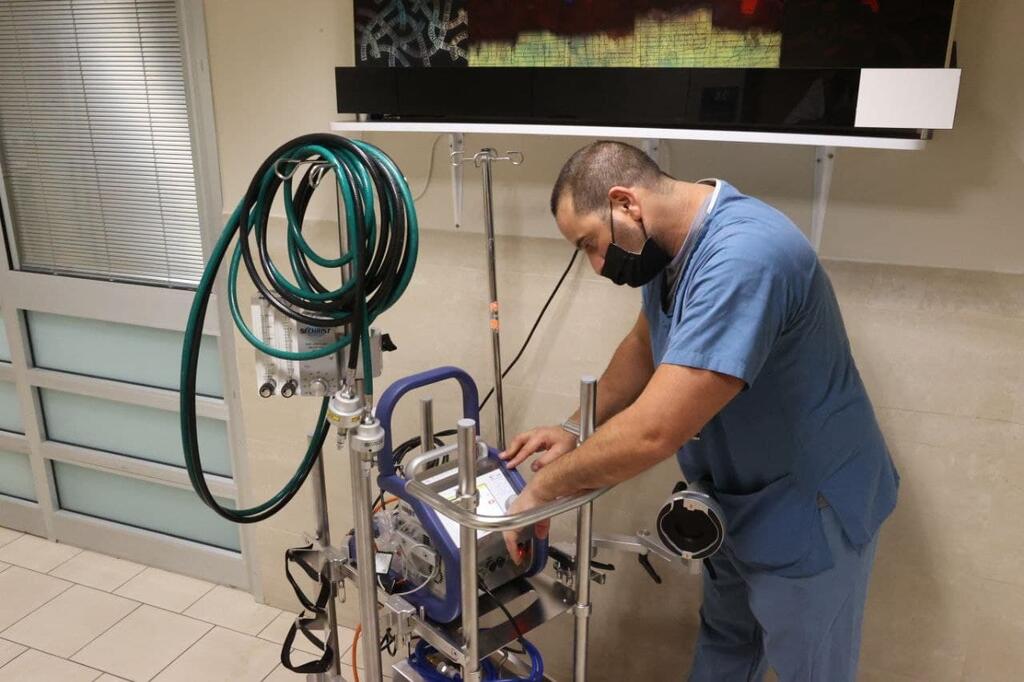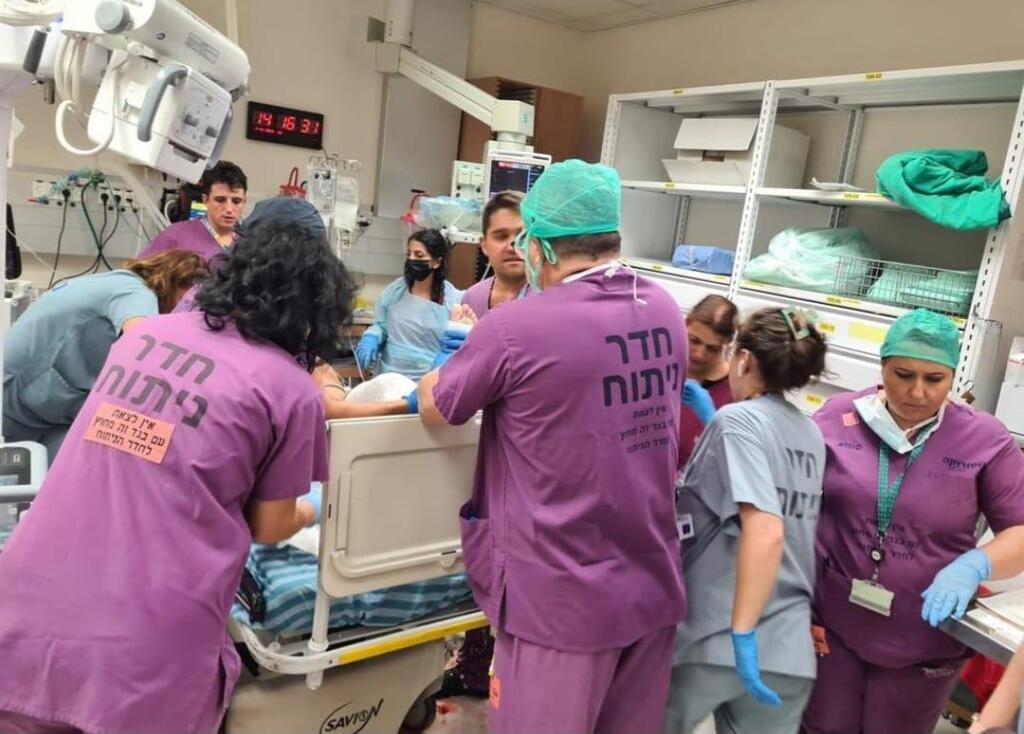Getting your Trinity Audio player ready...
Since the start of the war, 424 IDF soldiers have been seriously wounded, with 35 currently hospitalized. Some are suffering from severe lung injuries caused by explosions or chemical inhalation on the battlefield, rendering them unable to breathe.
Read more:
For the first time in Israeli conflict history, the ECMO (Extracorporeal Membrane Oxygenation) machine, which substitutes for the heart and lungs in severe lung disease and was a "star" during the COVID-19 pandemic, is being used to save the lives of soldiers critically injured in Gaza.
"These patients would not have survived without ECMO; in previous wars, they would have simply died on the field," says Dr. Uri Galante, director of the ECMO service for severe respiratory failure at Soroka Medical Center in Be’er Sheva.
There are currently three wounded soldiers connected to ECMO machines at Soroka, a device typically used in peacetime for gravely sick patients whose lungs are not functioning due to various diseases.
The severe injuries in the war have led Israeli teams to use this device for the first time on IDF casualties suffering from significant trauma, as a last, almost desperate, measure to save their lives. "Globally, ECMO use is recognized in trauma for a specific subgroup of war-injured," Dr. Galante says. "In Israel, it has not been done until now."
ECMO substitutes for the heart and lungs' functions. It draws blood from the body, oxygenates it, and then returns it. This treatment aims to preserve organ function while the body recovers from severe illness or injury, effectively "buying time" for patients with reversible damage.
"ECMO works directly on the blood, bypassing the lungs, allowing a patient to not breathe at all," says Dr. Galante. "Still, in most cases, the patient is connected to a ventilator to maintain the lungs' ability to function.
“Regardless of the cause of lung damage – be it a viral illness like COVID-19, chemical inflammation of the lungs from inhaled substances or an explosion – ultimately, the lung cannot perform its role. In such cases, ECMO has two functions: first, to replace the damaged lung, and second, to allow it to rest to accelerate the recovery process."
To date, 12 wounded soldiers have been treated with ECMO across the country, seven of them at Soroka alone. "We use this device for two populations of soldiers wounded in the war," says Dr. Galante, who also serves as a senior physician in the intensive care unit at the hospital.
"The primary group is those injured by explosions where the shock wave damaged their lungs, and soldiers who inhaled smoke from substances causing lung damage. These are the majority of patients currently needing ECMO. The second type includes those not directly injured in the chest or lungs but suffering from very complex multi-trauma and developing secondary lung damage.
"We are called to the hospital in the small hours of the night. Last week, it happened four times around two or three in the morning - to urgently connect a wounded soldier to ECMO who cannot be ventilated."
"Recently, we found ourselves treating multiple wounded soldiers with the device simultaneously. Unfortunately, this is no longer a rare event. We are called to the hospital in the small hours of the night. Last week, it happened four times around two or three in the morning - to urgently connect a wounded soldier to ECMO who cannot be ventilated."
The decision to connect a patient to ECMO is sometimes made immediately upon starting treatment, while their condition is still relatively good. "Already in the trauma room, we can identify those at high risk for severe lung injury," says Dr. Galante.
"The type of injury raises the suspicion that we might need the device. When the injury involves smoke inhalation or an explosion in an enclosed space, the likelihood of needing ECMO significantly increases.
“Often, these patients appear completely fine, are conscious and breathing on their own, but their condition can deteriorate very quickly, within hours, to a point where their lungs are not functioning at all. Therefore, it's preferable to connect them to ECMO as early as possible, before their condition deteriorates. Decision-making in a wounded soldier is done while they are still relatively fine, and you fear their condition will worsen. In other cases, you might say 'let's wait and see, maybe they will manage.' This paradigm does not apply in these cases."
Like many other treatments in the medical world, using ECMO is not without risks. "Often, the connection to the device is made under very extreme conditions, on the verge of resuscitation," Dr. Galante said.
"We insert very large tubes into the blood vessels and reach the heart. There's a potential risk for severe bleeding and even death during the operation."
'Operating such patients presents a dramatic challenge'
“In the first days following their injuries, the patients are extremely volatile, to the extent that you cannot leave their bedside due to the constant need for attention. It becomes a minute-by-minute fight for their lives,” Dr. Galante says.
“A patient connected to an ECMO machine is particularly complex, prone to bleeding and infections, requiring round-the-clock care. This intensive care demands a significant amount of manpower; each patient is assigned a personal nurse who remains in the room throughout the shift, focusing solely on them. Eventually, their condition stabilizes, but a severe lung injury remains, which takes time to heal. The number of patients treated with ECMO is relatively small, but the outcomes of this treatment are very positive.
Galante notes that the characteristics of the injuries seen among soldiers are markedly different from those seen in the past.
“We are familiar with lungs that bleed due to shock waves passing through them, but now we're seeing patients with lungs that leak fluids in large quantities. These are not the types of injuries we are accustomed to. We often find ourselves questioning what has changed, whether it's a matter of new weaponry,” he says.
“In the first days following their injuries, the patients are extremely volatile, to the extent that you cannot leave their bedside due to the constant need for attention. It becomes a minute-by-minute fight for their lives.”
“The patients arrive at the hospitals in critical condition, presenting a significant challenge that requires very aggressive interventions, accompanied by dilemmas about the best course of action.”
The battle to save the wounded is complex and demands a comprehensive therapeutic approach. "Their injuries require orthopedic surgeries, abdominal operations and vascular surgeries,” Dr. Galante says.
“These transitions are highly complex due to the patients' increased propensity for bleeding. Each surgery places a tremendous amount of stress on the patient. Even logistically, moving such patients to the operating room presents a dramatic challenge. A patient on ECMO needs three to five team members to ensure nothing shifts while they are being turned in bed. There are very rapid deteriorations, some of which we can manage and some we cannot."
“The morale of our unit hangs entirely on what happens to these patients. Sometimes, a single patient can dictate the mood of everyone. On a day when they stabilize, suddenly everyone is smiling, and the atmosphere becomes pleasant. However, this can change in an instant. The families are very much present here, far more than with regular intensive care patients. Their presence is deeply felt, adding to the emotional burden on the staff.
The heroic struggle for the lives of the wounded soldiers knows no bounds. "We never give up on anyone, no matter how severe their condition," says Dr. Galante.
"Ultimately, these are healthy, young people who were full of life just moments before their injury, at the very start of their journey. We cannot give up on them. We manage to save most of these soldiers. Most will return home with various injuries.
“When I visit them during rehabilitation, they are already laughing and walking with prostheses. There was a soldier injured by an RPG missile, arriving in a very critical condition, with severe brain and lung injuries. Today, he is breathing on his own, smiling and communicating. Every story like this, of someone who was on the brink and returned to life after being treated by us, gives us the strength to continue."






